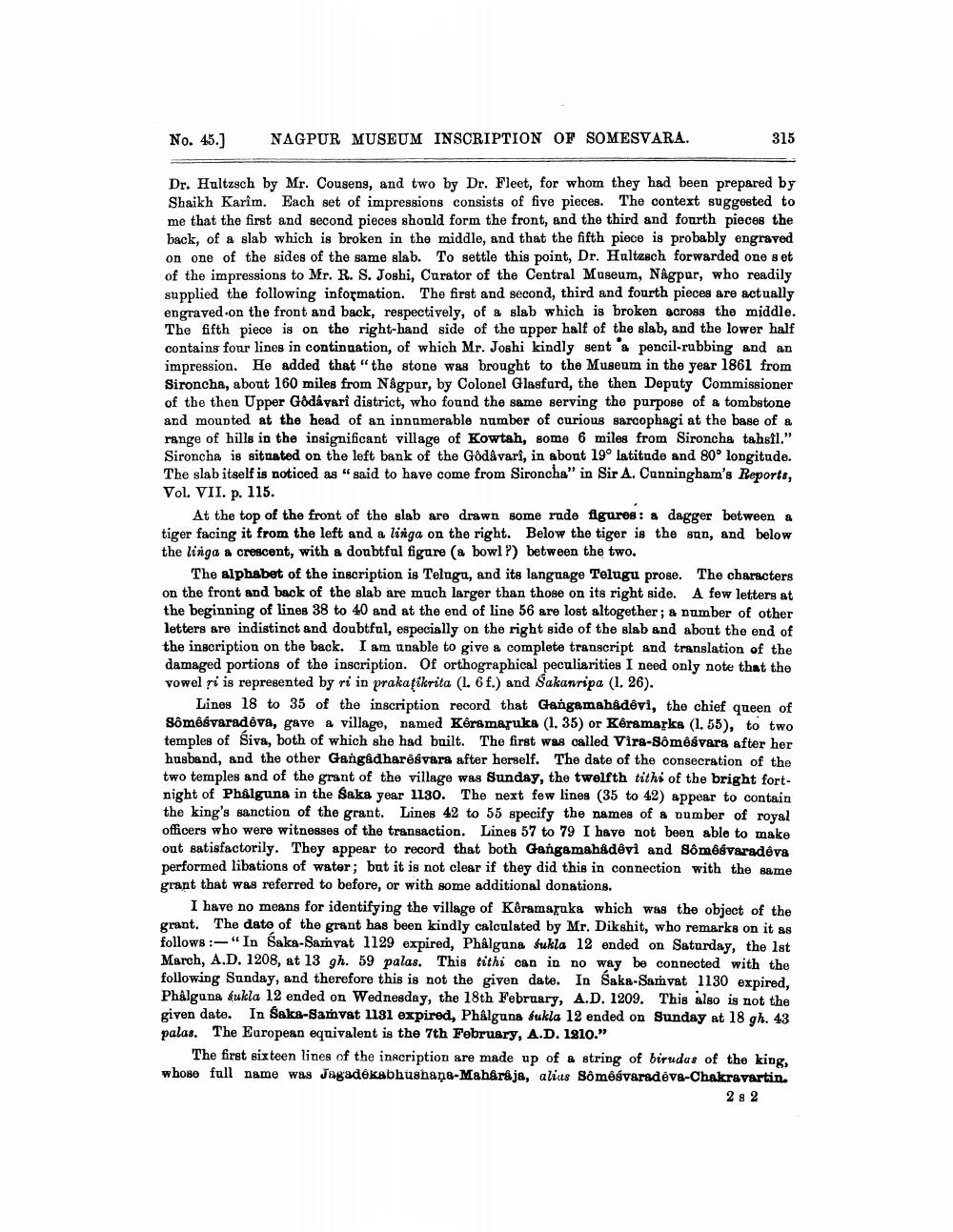________________
No. 45.]
NAGPUR MUSEUM INSCRIPTION OF SOMESVARA.
315
Dr. Hultzsch by Mr. Couseng, and two by Dr. Fleet, for whom they had been prepared by Shaikh Karim. Each set of impressions consists of five pieces. The context suggested to me that the first and second pieces should form the front, and the third and fourth pieces the back, of a slab which is broken in the middle, and that the fifth piece is probably engraved on one of the sides of the same slab. To settle this point, Dr. Hultzech forwarded one set of the impressions to Mr. R. S. Joshi, Curator of the Central Museum, Nagpur, who readily supplied the following information. The first and second, third and fourth pieces are actually engraved on the front and back, respectively, of a slab which is broken across the middle. The fifth piece is on the right-hand side of the upper half of the slab, and the lower half contains four lines in contingation, of which Mr. Joshi kindly sent & pencil-rubbing and an impression. He added that the stone was brought to the Museum in the year 1861 from Sironcha, about 160 miles from Någpur, by Colonel Glasfurd, the then Deputy Commissioner of the then Upper Godavari district, who found the same serving the purpose of a tombstone and mounted at the head of an innamerable number of curious sarcophagi at the base of a range of hills in the insignificant village of Kowtah, some 6 miles from Sironcha tahsil." Sironcha is situated on the left bank of the Godavari, in about 190 latitude and 80° longitude. The slab itself is noticed as "said to have come from Sironcha" in Sir A. Cunningham's Reports, Vol. VII. p. 115.
At the top of the front of the slab are drawn some rude figures: & dagger between & tiger facing it from the left and a linga on the right. Below the tiger is the son, and below the linga a crescent, with a doubtful figure (a bowl P) between the two.
The alphabet of the inscription is Telugu, and its language Telugu prose. The characters on the front and back of the slab are much larger than those on its right side. A few letters at the beginning of lines 38 to 40 and at the end of line 56 are lost altogether; a number of other letters are indistinct and doubtful, especially on the right side of the slab and about the end of the inscription on the back. I am unable to give a complete transcript and translation of the damaged portions of the inscription. Of orthographical peculiarities I need only note that the vowel ri is represented by ri in prakaţikrita (1. 6 f.) and Sakanripa (1. 26).
Lines 18 to 35 of the inscription record that Gangamahadevi, the chief queen of Sômêsvaradeva, gave a village, named Keramaruka (1.35) or Keramarka (1.55), to two temples of Siva, both of which she had built. The first was called Vira-Sômêsvars after her husband, and the other Gangadharêgvara after herself. The date of the consecration of the two temples and of the grant of the village was Sunday, the twelfth tiths of the bright fortnight of Phålguna in the Saka year 1130. The next few lines (35 to 42) appear to contain the king's sanction of the grant. Lines 42 to 55 specify the names of a number of royal officers who were witnesses of the transaction. Lines 57 to 79 I have not been able to make out satisfactorily. They appear to record that both Gangamahadevi and Sômêsvaradeva performed libations of water; but it is not clear if they did this in connection with the same grant that was referred to before, or with some additional donations.
I have no means for identifying the village of Keramaraka which was the object of the grant. The date of the grant has been kindly calculated by Mr. Dikshit, who remarks on it as follows:-"In Saka-Samvat 1129 expired, Phålgana sukla 12 ended on Saturday, the 1st March, A.D. 1208, at 13 gh. 59 palas. This tithi can in no way be connected with the following Sunday, and therefore this is not the given date. In Saka-Samvat 1130 expired, Phålguna kukla 12 ended on Wednesday, the 18th February, A.D. 1209. This also is not the given date. In Saka-Samvat 1131 expired, Phâlguna sukla 12 ended on Sunday at 18 gh. 43 palas. The European equivalent is the 7th February, A.D. 1910."
The first sixteen lines of the inscription are made up of a string of birudas of the king, whose full name was Jagadekabhushana-Maharaja, alias Sômêsvaradeva-Chakravartin.
28 2




